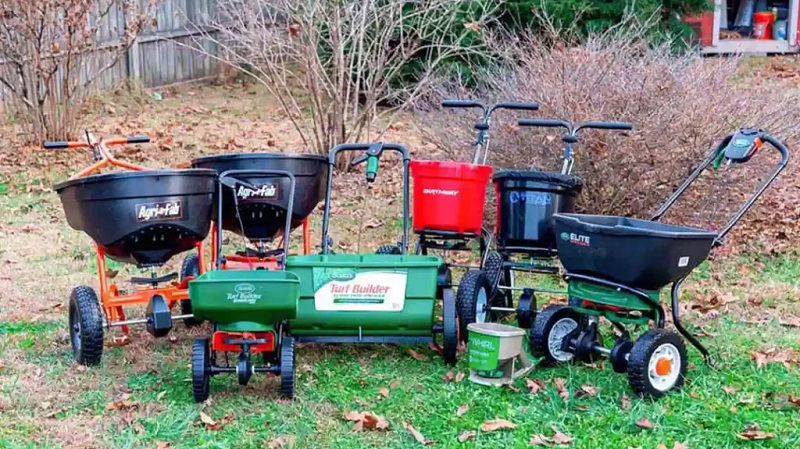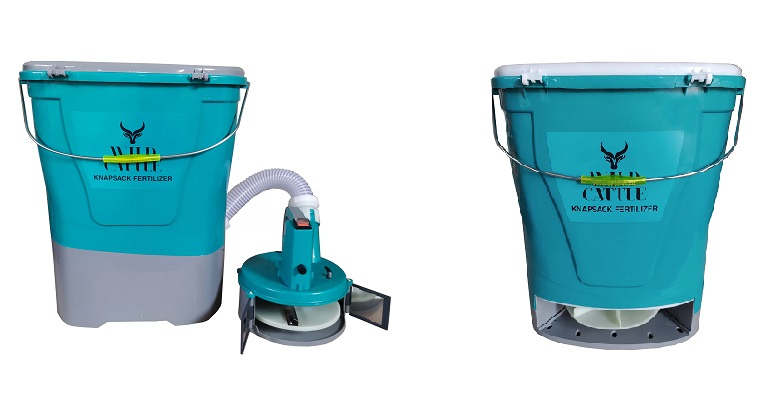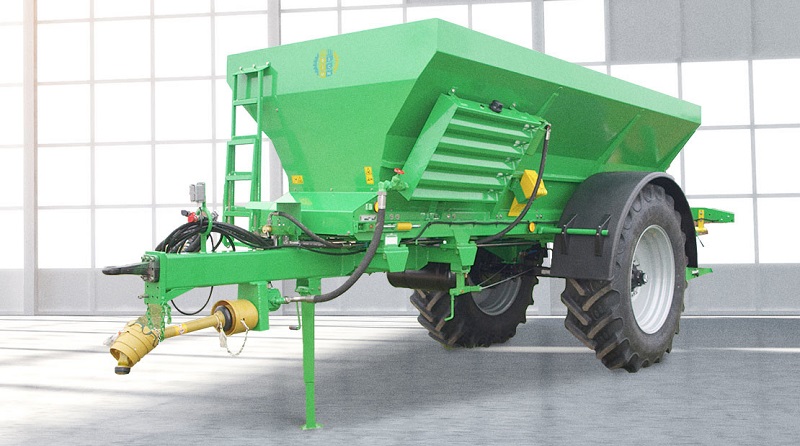
Introducing and comparing types of fertilizer spreader machines
Fertilizer application is a routine and repetitive operation in agriculture carried out to supply plants with the necessary nutrients. Farmers apply various liquid and solid fertilizers to orchards and fields several times a year. In the past, fertilization was done manually and using traditional methods. However, thanks to technological advancements, various types of fertilizer application machines have been introduced. In this article, we will explain the advantages of fertilizing with a fertilizer spreader machine. We will also introduce different types of fertilizer spreader machines.
What is a fertilizer spreader?
Historically, plants were fertilized using traditional, manual methods. These methods posed various problems. Manual fertilization led to uneven distribution of fertilizer, with some areas receiving too much while others received none at all. This approach was also time-consuming and labor-intensive, particularly on large land plots. To tackle these challenges, fertilizer spreader machines have been developed.
A fertilizer spreader machine is a tool used to disperse and distribute various organic and chemical fertilizers in fields, ensuring uniform spread across fields, orchards, lawns, gardens, and green spaces. Also, you can check out our guide to improve lawn.
Using a fertilizer spreader machine ensures that fertilizer is distributed precisely in the field, which helps prevent fertilizer wastage and increases agricultural efficiency. In small farms where there is limited space, manual or battery-powered spreaders are often used. In larger fields or urban green spaces, tractor-mounted fertilizer spreaders are employed.

Advantages of using a fertilizer spreader
Using a fertilizer spreader in agriculture has several important advantages:
- Uniform Fertilizer Distribution: A fertilizer spreader enables uniform distribution of fertilizer across the field, preventing fertilizer wastage and optimizing its use.
- Increased Efficiency: With precise fertilizer distribution, plants uniformly benefit from nutrients, leading to increased final yields.
- Improved Product Quality: Timely and regular fertilization of the soil enhances the quality of the produce.
- Savings in Fertilizer Usage: Uniform fertilizer spreading through a spreader reduces fertilizer consumption compared to manual methods.
- Environmental Preservation: Reduced fertilizer usage decreases pollution from excess runoff into groundwater and surface water.
- Enhanced Work Efficiency: The use of a fertilizer spreader significantly increases work efficiency compared to manual spreading.
- Enhanced Accuracy and Control: Fertilizer spreaders allow precise control over the rate of fertilizer distribution, enabling farmers to determine the exact amount of fertilizer needed.
- Cost Reduction: Employing a spreader reduces ongoing costs and optimizes human resources.
- Fertilization at All Growth Stages: these machines allow you to fertilize at any stage of crop growth, adjusting the application based on soil requirements. These machines can control the spread width and rate depending on soil conditions.

What are the most common agricultural fertilizer spreaders?
Fertilizer devices can be classified in several ways:
- Classification based on power source (diesel, electric, manual)
- Classification based on the type of fertilizer
- Classification based on fertilizer tank capacity
- Classification based on the method of fertilizer distribution (uniform spreading or broadcasting)
- Classification based on type of movement (towed, self-propelled)
- Classification based on surface coverage extent
Classification based on power source
Fertilizer spreader systems can be divided into three categories: manual fertilizer spreaders, battery-powered fertilizer spreaders, and tractor-mounted fertilizer spreaders.
Manual Fertilizer Spreader
Manual fertilizer spreaders are lightweight and portable. These devices are mechanical and are used for spreading fertilizer in small fields and gardens. To use a manual fertilizer spreader, you first need to fill the tank with fertilizer and adjust the fertilizer outlet valve. By doing this, you can control the amount of fertilizer spread. Some manual fertilizer spreaders have additional features such as adjustable spreading speed and depth of fertilization.
Battery-Powered Fertilizer Spreader
Battery-powered fertilizer spreaders use rechargeable batteries for movement and fertilizing. These devices do not have internal combustion engines or complex parts, so the maintenance and repair costs are not high. Battery-powered fertilizer spreaders are lightweight and compact, making them easy to transport and suitable for use in small farms.
Battery-powered fertilizer spreaders come in two types: simple battery-powered spreaders and backpack battery-powered spreaders. In simple battery-powered spreaders, the device’s blade is integrated inside its body. However, this is not the case for backpack models. In backpack models, the device’s output is connected to a movable handle through a tube. Fertilizer is transferred from the tank to the handle through the tube, where it is then distributed.

Mechanical Fertilizer Spreader
Mechanical fertilizer spreaders are usually towed by tractors or other vehicles. They come in small and large sizes, with larger models being mounted on tractors and smaller ones attached to agricultural tillers.
Tractor-mounted fertilizer spreaders use a large tank to hold fertilizer and a spreading system to distribute it. These machines have complex systems for adjusting the amount of fertilizer used. They are commonly used to fertilize large fields and pastures.

Classification of Fertilizer Spreaders Based on Fertilizer Type
From the perspective of the type of fertilizer used, fertilizer spreaders can be categorized into two groups.
Organic Fertilizer Spreaders
Organic manure spreaders are used to apply natural fertilizers to the soil. These spreaders are divided into two categories: liquid and solid organic fertilizer spreaders. Solid organic fertilizer spreaders are the most suitable option for applying manure-based fertilizers. On the other hand, liquid organic fertilizer spreaders store fertilizer derived from animal waste in their tanks and distribute it to the soil surface through discharge pipes.
Chemical Fertilizer Spreaders
Chemical fertilizer spreaders come in two types: solid and liquid. Solid spreaders use disc rotation for mixing and even distribution of fertilizer, allowing for the application of substances like ammonium sulfate crystals. Liquid spreaders, on the other hand, can introduce various types of liquid chemical fertilizers into the tank and inject them into the soil.
Which Type of Fertilizer Spreader is Suitable for My Land?
The type of fertilizer spreader that is suitable for your land depends on various factors, including the size and shape of the land, the type of fertilizer used, and your budget for acquiring a spreader. When selecting the appropriate fertilizer spreader, consider the following:
- Size and Shape of the Land: If your land is small, Battery-Powered or manual fertilizer spreaders are ideal. For larger plots, tractor-mounted or mechanical spreaders are more suitable.
- Type of Cultivated Crops: For grain crops like cereals, broadcast spreaders are suitable. For vegetables and greens, row spreaders that allow more precise fertilizer distribution are better.
- Amount of Fertilizer Needed: If the required amount of fertilizer is low, small Battery-Powered spreaders are a good option. For higher fertilizer requirements, larger spreaders and tractor-mounted ones are recommended.
- Access to Power Source: If access to electricity is limited, manual spreaders are better. If you have good access to power, battery-powered spreaders are a more suitable option.
- Consider the Type of Fertilizer: If you intend to spread solid fertilizers, you should use spreaders designed for this type of fertilizer. For liquid fertilizers, you can use specialized liquid fertilizer spreaders or multipurpose spreaders.
Taking these factors into consideration, you can choose the most suitable fertilizer spreader for your agricultural land. Our recommendation is to make the final decision in consultation with an agricultural expert. Also, we suggest you take a look at the stages of preparing agricultural land, before deciding on when to use a fertilizer.
Fertilizer Spreader Prices
The purchase of a fertilizer spreader incurs a cost for the farmer based on the brand and type of the device. However, this device will significantly reduce a portion of the farmer’s future expenses.
The price of a fertilizer spreader depends on factors such as the type of device, capacity, brand, and features. For accurate pricing information, you can visit agricultural equipment stores. Additionally, you can find a list of online agricultural equipment stores and review the prices and specifications of each device in the products section of these websites.
